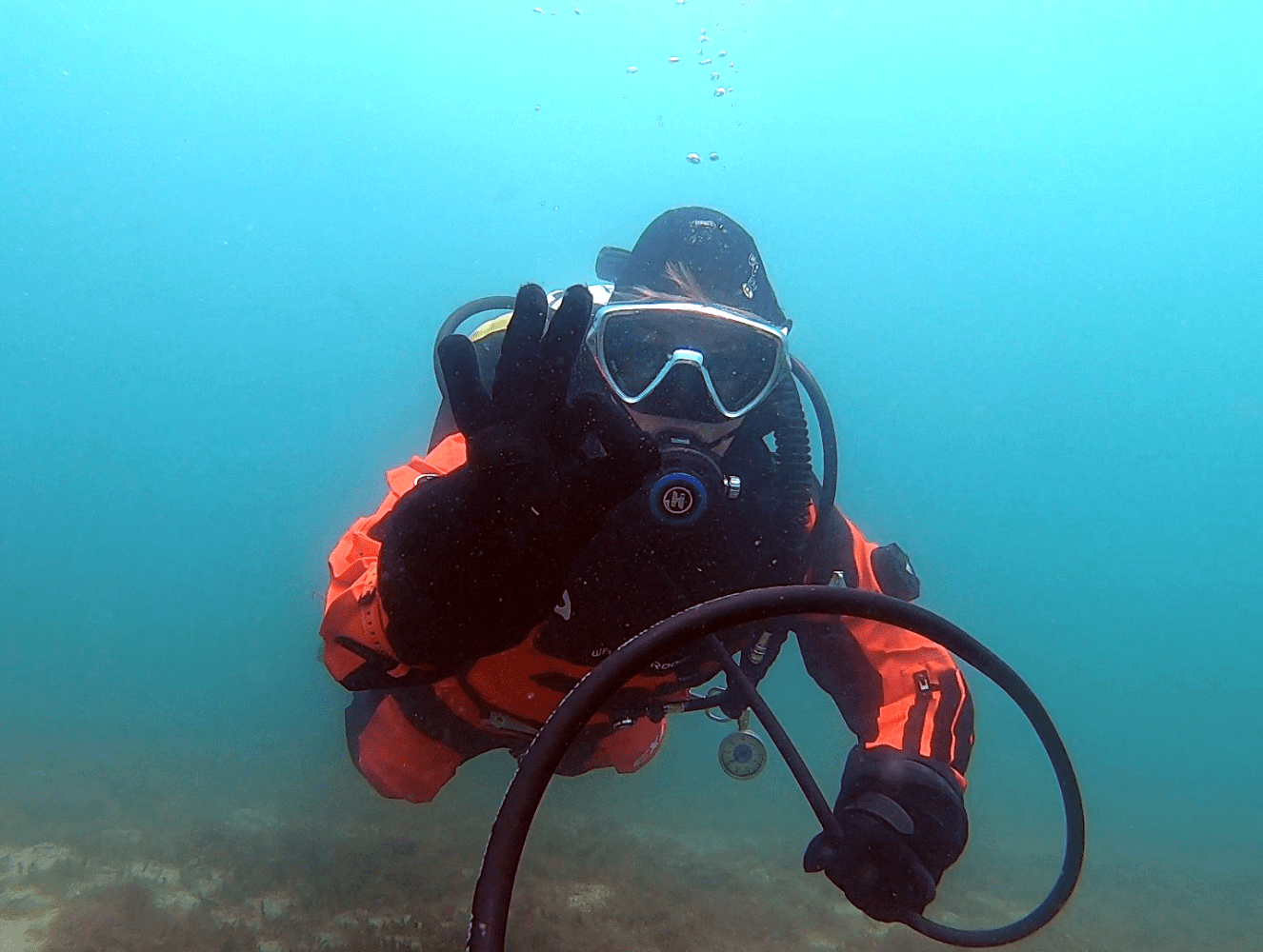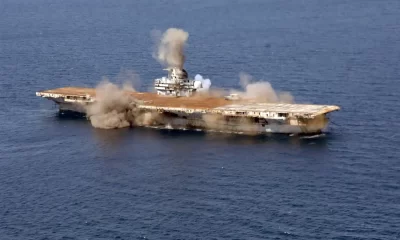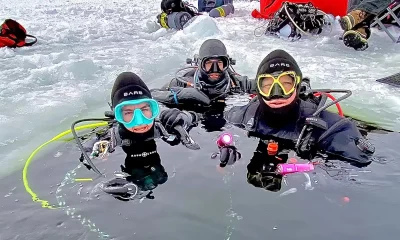Community
Never Too Late: Veteran Sports Diver Tackles GUE Fundamentals
What did a 56-year old PADI Open Water Scuba Instructor with 30-years of experience take away from her “Fundies” class? OZTek owner/operator Sue Crowe reports a rekindled “joy” of learning, new skills, new friends, and some new diving goals!

By Sue Crowe
Header photo courtesy of Sue Crowe.
“Keep your knees together, Sue.” GUE Instructor Examiner Guy Shockey explains the details of Fundamentals, GUE’s most popular course, which he characterizes as “simple things done precisely!”
Taken aback, I quickly looked at Duncan, my instructor. The comment was delivered in a sincere, helpful tone, without a hint of a smirk. Impressive! He’d even written it on the board to remind me to practice. I grinned. Broadly. I honestly couldn’t remember anyone telling me to keep my knees together. Ever. But looking at the video footage, I could see exactly what Duncan meant. Wow. It was so obvious. My Global Underwater Explorers’ (GUE) Fundamentals course provided many surprises; it also delighted, sobered, and ultimately, made me proud!
Lots of people have asked me why, a 56-years old PADI Open Water Scuba Instructor (OWSI), who has been diving consistently for 30 years, decided to take GUE Fundamentals. After all, I’d been preparing for my big trip to Antarctica. I’d done several dives in the new drysuit. I’d chosen my undergarments, and I’d organised my weights. I ought to be feeling comfortable right? I should be ready.
Well, yes, but there is always room to learn more. The Fundamentals course, or “Fundies” as it’s called, is all about preparation: teamwork, buoyancy, trim, task loading— the fundamental skills required to go further, to explore. I’ve got a lot of GUE friends and have been eyeing the course for a while. Now seemed like the perfect opportunity to discover what all the fuss was about.
Indeed, on day one, we were asked to state our course objectives/goals. Mine were very simple:
- Discover for myself what GUE was about;
- Perfect buoyancy, weight, equipment, and trim in my new drysuit BEFORE heading off to complete my absolute bucket-list top slot, diving the Antarctic; and, most importantly;
- Have fun and learn new stuff
I had only my pride to dent, and nothing to lose.
Truth be told, I was apprehensive. I hadn’t taken a dive course for years, either as an instructor or a student. Most of the time, I felt I could hold my own around divers. I know my limitations and, for the most part, stick rigidly to them. But were my assumptions correct? I was about to find out, and reality isn’t always pretty.
Ironically, the week before starting the course, in order to practice with my new dry suit, I was diving in New Zealand with some friends who are highly experienced rebreather divers. I was diving on a single cylinder, with borrowed equipment and some borrowed fins.
The diving was amazing, but for the first couple of days I struggled. The Jetfins were too big— they flopped around on my feet, making it difficult to control the air in my feet (in my dry suit). Strangely, it wasn’t until the third day that I gave up using them and borrowed a standard pair of recreational fins. Finally, it felt like I had everything under control and I had my mojo back.
Another lesson: trust your instincts, and don’t be afraid to buck the system when something doesn’t feel right.
A Little About GUE
Immediately following my NZ lesson, I smashed straight into Fundamentals. My confidence was not high. It was tough walking into the dive shop knowing I was going to be taught, and judged. Ming, my classmate, was working for her Tech pass, wearing doubles, which would enable her to move on to GUE’s technical training courses. I did the class with a single cylinder. More pressure.
Many things are said about GUE, and not all of them kind. One comment I heard repeatedly was, “GUE—where fun goes to die!” BUT there is no denying the effectiveness of the training nor the philosophy moving forward if you have exploration in your sights. The essential philosophy is a simplified but big step up on general training agencies. GUE’s standard equipment setup and standard gases are the biggest distinguishing features.
Another BIG difference is the high level of skill taught and expected. Plus, there is absolutely no guarantee that you will pass—something that’s stated very clearly at the beginning of the course. I found it extremely reassuring. I didn’t want a certificate of participation. I wanted to deserve my card. GUE Fundamentals is exactly what it says it is: “teaching the basic fundamental skills required to be competent and to comfortably dive underwater.” It is the groundwork from which to build on.
GUE boasts an impressively high level of Instructor competency. Every GUE instructor is required to pass an annual fitness test and demonstrate both teaching and diving currency at the highest levels of their qualification. I like that, especially as you go further into more advanced levels of training and finally, exploration, deep wreck, and cave training.
I also like, and value, the idea of high level expedition teams all being on the same page, with similar diving levels, being able to react without thinking. Makes good sense to me.
Anatomy of a Fundamentals Class

GUE Instructor Examiner Guy Shockey explains the details of Fundamentals, GUE’s most popular course, which he characterizes as “simple things done precisely!” For a detailed description of Fundamentals see: Anatomy of a Fundamentals Class.
But did I have what it takes?

I chose Dive Centre Bondi (DCB) because of their reputation and the reputation of instructor and owner Duncan Paterson. Though both Dive Centre Bondi and Dive Centre Manly in Sydney were nearby and have excellent reputations, I had never dived with DCB and they didn’t know me very well. I decided that if I was going to do this, I might as well take myself completely out of my comfort zone and go with someone new. So out of my comfort zone I went. The course was four days, six dives (minimum) and usually, but not necessarily, taken over two weekends. The first weekend was a shock.
Day One: Getting Started
Duncan gave an introduction to GUE, including its philosophy and background. We were also given a series of new fin kicks to learn, a briefing on what to expect over the coming days, along with some video skills demonstrations. I was impressed.

We performed a hilarious (although invaluable) walkthrough of skills in the carpark, and then, with our brains buzzing, we were off to the iconic Bondi Icebergs ocean pool—home of Sydney’s beautiful people (yikes!) to complete a swim competency test: 15 meters underwater in one breath, and a 275 meter/300 yard swim in under 14 minutes.
I was glad to get in the water. As a regular, and a strong swimmer, the worst part was walking onto the swim deck surrounded by young, gorgeous bodies (including my very lovely erstwhile fellow student, Ming, looking spectacular in a bikini). I was sporting my very middle-aged self in a black, sensible swimsuit. Ho hum! Six minutes later, I was relieved to be back in the changing rooms, with one of the trials on our checklist ticked off.
Day Two: Diving (The real stuff!)
After the usual faffing, we got in the water, were briefed and ready to rock by 10 am. My buoyancy was okay, but after 30 years of quietly finning in my own way, now mastering the flutter kick, the modified flutter kick, and the modified frog humbled me, to say the least. I was hopeless, nor were my muscles very happy. It was so much more annoying to watch Duncan glide effortlessly through the water only to discover my legs simply didn’t want to cooperate. Thank goodness for my frog kick—one small saving grace. I loved the day, enjoyed learning the new kicks, but was extremely frustrated with my own inability to get it right.
We worked to truly bring it home, and our efforts were videoed. We returned to the classroom for a full debrief. I prepared myself; I knew it wasn’t going to be pretty.
Watching yourself on screen, the struggle is obvious (not to mention hilarious). You can literally see, in graphic detail, all of your mistakes. It’s a brilliant training tool, allowing Duncan to explain exactly what was working, what wasn’t, and to supply helpful tips and ideas to facilitate improvement.
In comparison to the kicks, the “Basic Five” skills (Reg replacement / Reg Swap / Long hose deployment for sharing air / partial mask clear / full mask removal and recovery) were bliss! I loved this, even though I did forget a few of the steps, for example, clipping off the first stage and not pulling the long hose out until my buddy was calm. It was great to simply learn and practice.
After the amusing, but sobering, reality of my kicking prowess settled in, we tackled the math of surface consumption rates, and minimum gas (aka dive planning and gas management). I went home determined and exhausted. I had five days before we were back in the water.


For some inexplicable reason, Ming and I chose to take our Fundies on the two weekends prior to Christmas! Go figure. My week was chaotic. No leisurely dive practice for me. I was left with the carpet. After all, logic told me that if skill practice worked in the car park, why not on the carpet?
Trust me, when attempting to keep your knees together, and up, the carpet made perfect sense (not to mention, it was more comfortable than the asphalt). It’s physically impossible to drop your knees while lying face down on something solid. Keeping them shut is more challenging. I simply concentrated on the motion and proved to my own legs that it WAS physically possible. Much to my husband’s amusement, I practiced everyday, even if it was a quick five minutes.

Five days later, I returned, feeling optimistic but unsure how good my carpet skills would translate to open water.
Day Three: On To The Divesite
After the usual friendly greetings and a quick brief, we loaded our gear, headed to the dive site for an onsite briefing, a practice session prior to the official class, and then, the real McCoy. Apart from practicing our fin kicks (A LOT!), we covered S-drills, ascents (with stops), descents, and more Basic Five, all with the GUE mantra in mind:
- Team (where are your team members/situational awareness etc)
- Buoyancy
- Trim
- Skill (the skill being the least important if all the others go to pot)
Thank God for carpet practice. Day three was a vast improvement. Definitely not perfect, but both Ming and I felt better about our performances. There was less self-deprecating laughter (an invaluable skill in any situation), more determination, more accomplished smiling, and a light at the end of the tunnel was clearly visible. I really started to enjoy myself.
After two practice sessions and two class dives, where we spent over four hours underwater, things were going great. Reviewing the video was easier too. In fact, we were eager to see it, and the difference was obvious. Very gratifying. Despite small errors, we were on the way.
It was a long day; four hours underwater, a de-brief followed by a classroom session on partial pressures and gas planning (yes, there is an exam at the end). I dragged myself home and fell into bed dreaming of the perfect flutter kick.
Day Four: Our final classroom day

There it was on the board: our final reminders. Keep those knees together. I grinned.
After the success of day three, wewere raring to go. We’d agreed to start off early. Today was a big, final day. With tea and coffee assistance (plus a deliciously indulgent cinnamon bun), we had our final theory lecture on gas dynamics.
As well as successfully completing all the underwater skills including ascents and descents, today heralded the anticipated (and very specific) Surface Marker Buoy (SMB) deployment, along with an unconscious diver recovery. Our no-mask swim was unpleasant (especially with my contact lenses), but it’s one of those exercises that needs to be done, and is especially valuable if your mask does happen to get dislodged one day.
Note to contact wearers: Opening one’s eyes underwater in the ocean is NO problem. Don’t however, try it in a swimming pool or freshwater. Contacts do not like it, nor will you.
We had a lovely day at Camp Cove. Our SMB deployment and land practice, prior to trying it underwater, was a joy. Both Ming and I showed further improvement. Ming’s valve drill was impressive to watch. I was pleased with my Basic 5 and didn’t forget anything this time. The hours in the water flew by. We headed back to the shop for more video debriefing and the final exam.
Because of GUE’s policy of keeping all videos shot during class private, we all agreed to do a fun dive on the following Monday morning to enjoy our newly developed skills and take some video footage for me to use in this story. (Thank you team).
It wasn’t quite over yet, but I’d spent four intense days with Duncan and Ming. We’d had loads of fun and laughs, shared the lows and the wins. I felt sad it was coming to an end, and I’d have to go back to the real world. Sigh.
In Conclusion
I loved every minute of this course. I laughed. My teammate was awesome. Duncan was a brilliant instructor, immeasurably patient, good fun, and nothing was too much trouble for him. It was obvious he genuinely wanted us both to improve, learn, and prevail.
I’m sure a lot depends on the individual instructor; in diving it always does. However, GUE consistently tests and stretches its instructors, and the bar for admission is very high.

Certainly the scope and skill level for the course was excellent grounding for any diver.
Not that this is NOT a ‘learn to dive’ course. I, with Ming, who is a PADI Rescue Diver, were a good combo. We both had fun and learned new skills. The atmosphere of this class was open and honest. We were encouraged to admit if things weren’t working as expected, and we were given feedback and advice. It was a safe, no-blame environment which both Ming and I responded well to.
After such a long time out of the classroom, as either an instructor or student, I had forgotten what a joy it is to learn. I’m still working on the perfect backward kick, but my course objectives were well and truly met. To top it off, I made two new friends.
Forget a 20-minute refresher course if you want to get back into diving or want to feel more confident. Go and tackle GUE Fundamentals–a truly welcoming, friendly environment where it’s safe, and you’re encouraged to learn. Any diver, no matter how ‘skilled’ or experienced, would benefit from this course.
What’s next for me? Apart from my coming trip to Antarctica (see my vlogs & blogs—an unrepentant plug), I’m determined to complete my GUE doubles primer and nail that Tech Pass within six months! The ocean is a big place – plenty of room for expansion. Maybe this is my own private middle-aged crisis, but it’s certainly better than a fast car (IMHO) 🙂 but I certainly don’t intend to stop learning new things anytime soon.
Note: GUE has a policy not to allow any class video footage to be used for anything other than training purposes. ALL footage used in this article was taken in practice sessions prior or after ‘official training’ with an additional day diving after the course, for the specific purpose of shooting video. Any shots shown have the express consent of all participants.

A journalist by trade, Sue was the Editor of Scuba Diver Australasia, has driven her own marketing consultancy and been Director of Tabata Australia. Today, Sue owns and operates OZTek Advanced Diving Conference and OZDive Expo, Australia’s most successful diving show. Passionate about diving and all those in it, Sue is a member of the Dive Industry Association of Australia, long time member of the Australian Marine Conservation Society and is Webmaster and Australasian Co-ordinator of the Our World Underwater Scholarship Society. Although not actively teaching today, Sue, a PADI OWSI since 1993, has been an active diver since 1990.





















































